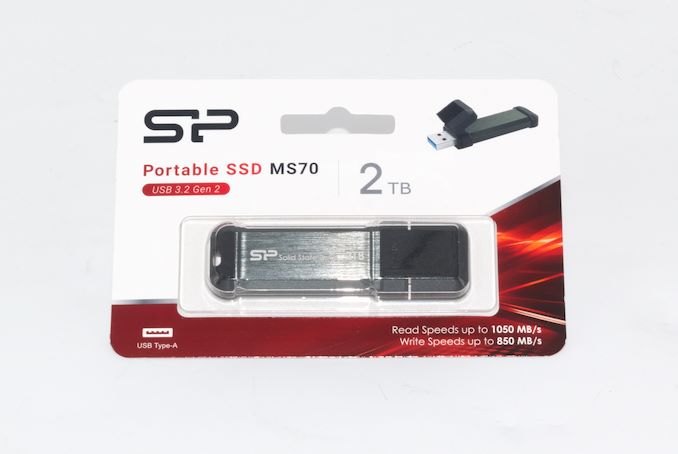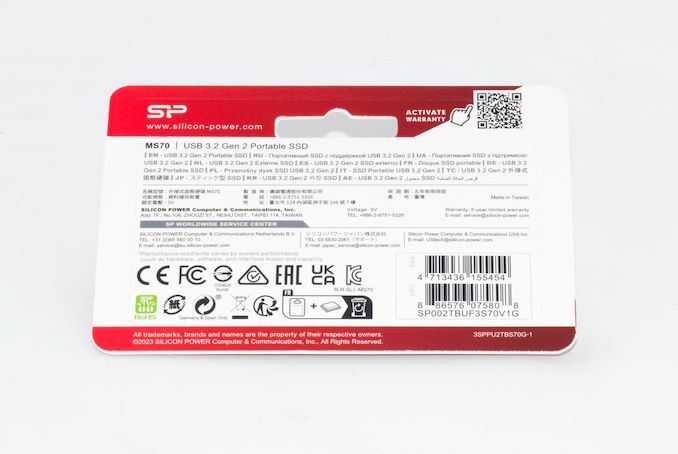Silicon Power MS70 SSD-in-a-Stick Review: Thumb Drive Meets Massive Capacity
by Ganesh T S on December 21, 2023 8:00 AM EST
Silicon Power's flash storage product line caters extensively to the entry-level market. In October 2023, the company introduced two new portable SSDs in a thumb drive form-factor. The MS70, with a single USB 3.2 Gen 2 Type-A interface, is now available in capacities ranging from 250GB to 2TB. The DS72 (also available in the same capacities) has a dual-interface design with both Type-C and Type-A interfaces. Performance claims of 1050 MBps reads and 850 MBps writes land the MS70 and DS72 in the high-capacity high-performance UFD segment.
The company has traditionally relied on introducing products into well-established market segments, with specifications that do not typically make them stand out. However, the two new products caught our attention, as they happen to be one of the first reasonably-priced 2TB thumb drives in the retail market.
The high-performance USB flash drive (UFD / thumb drive) segment has been steadily gaining more entrants since the introduction of Kingston's DataTraveler Max in late 2021. Transcend's ESD300 and ESD310, along with Silicon Power's MS70 and DS72 are making an attempt to differential themselves from the rest of the pack by offering 2TB SKUs. This review takes a detailed look at the performance and value proposition of the 2TB version of the Silicon Power MS70.
Introduction and Product Impressions
USB flash drives have grown both in storage capacity and speeds over the last few years. Thanks to the advent of 3D NAND and rapid iterations with performance improvements in the USB specifications, we are now seeing SSD-in-a-stick products capable of delivering 1GBps+ speeds.
The thumb drive form factor is attractive for multiple reasons - there is no separate cable to carry around, and the units are usually light and compact. High-performance thumb drives based on SSD platforms were introduced in the mid-2010s, but the thermal solution and size made them unwieldy. The category was made viable only after the introduction of high-performance native UFD controllers from Phison and Silicon Motion. We have already reviewed multiple PSSDs based on these two controllers, including the Transcend ESD310C and the OWC Envoy Pro Mini in the thumb drive category.
The new Silicon Power MS70 aims to differentiate itself from other high-performance thumb drives based on two aspects - available capacity points, and compact case design. Despite its thumb drive form-factor, the MS70 takes full advantage of its USB 3.2 Gen 2 Type-A connector by promising speeds of up to 1050 MBps. The company sampled us the 2TB version to put through our direct-attached storage test suite.
The thumb drive is the only component in the package, and all of the usage and warranty information is printed on the back. Our sample came from an early batch, as the same SKU currently being sold also includes a Type-A to Type-C adapter.
There are no value-additions like lanyards or bundled software, but that is reflected in the aggressive pricing strategy adopted by Silicon Power - around 5¢ per GB for the highest capacity SKU. In any case, the target market for these thumb drives is unlikely to be enticed by backup software or hardware encryption-supporting password applications.
The casing is made of rubber and aluminum, with the former in place around the edges and the connector's protective cap. The product has a sturdy feel to it, unlike the relatively flimsy construction of the Transcend ESD310C. The MS70 is slightly larger, but the dimensions are still small enough to avoid problems with port blocking.
There was no obvious way to tear down the sample for the purpose of determining the controller and the flash being used. However, CrystalDiskInfo provides a quick overview of the capabilities of the storage device. A look at the firmware version (UHFM00.6) and a cursory online search revealed that the Silicon Power MS70 is powered by the Phison U17 controller. Silicon Power confirmed the use of SK hynix 3D TLC NAND in our sample, but did mention that they reserved the right to use any NAND with similar performance in future production runs.
| S.M.A.R.T Passthrough - CrystalDiskInfo | |
 |
|
The table below presents a comparative view of the specifications of the different thumb drives presented in this review.
| Comparative Direct-Attached Storage Devices Configuration | ||
| Aspect | ||
| Downstream Port | Native Flash | Native Flash |
| Upstream Port | USB 3.2 Gen 2 Type-C | USB 3.2 Gen 2 Type-C |
| Bridge Chip | Phison U17 | Phison U17 |
| Power | Bus Powered | Bus Powered |
| Use Case | Sturdy pocket-sized SSD in a thumb drive form-factor with a Type-A interface | Pocket-sized SSD in a thumb drive form-factor with both Type-A and Type-C interfaces |
| Physical Dimensions | 21.3 mm x 71.3 mm x 10.4 mm | 17 mm x 80 mm x 11 mm |
| Weight | 13.8 grams | 26 grams |
| Cable | N/A | N/A |
| S.M.A.R.T Passthrough | Yes | Yes |
| UASP Support | Yes | Yes |
| TRIM Passthrough | Yes | Yes |
| Hardware Encryption | Not Available | Not Available |
| Evaluated Storage | SK hynix 3D TLC | ??? 3D TLC |
| Price | USD 101 | USD 481 |
| Review Link | Silicon Power Portable SSD MS70 2TB Review | OWC Envoy Pro Mini 1TB Review |
Prior to looking at the benchmark numbers, power consumption, and thermal solution effectiveness, a description of the testbed setup and evaluation methodology is provided.
Testbed Setup and Evaluation Methodology
Direct-attached storage devices (including thumb drives) are evaluated using the Quartz Canyon NUC (essentially, the Xeon / ECC version of the Ghost Canyon NUC) configured with 2x 16GB DDR4-2667 ECC SODIMMs and a PCIe 3.0 x4 NVMe SSD - the IM2P33E8 1TB from ADATA.
The most attractive aspect of the Quartz Canyon NUC is the presence of two PCIe slots (electrically, x16 and x4) for add-in cards. In the absence of a discrete GPU - for which there is no need in a DAS testbed - both slots are available. In fact, we also added a spare SanDisk Extreme PRO M.2 NVMe SSD to the CPU direct-attached M.2 22110 slot in the baseboard in order to avoid DMI bottlenecks when evaluating Thunderbolt 3 devices. This still allows for two add-in cards operating at x8 (x16 electrical) and x4 (x4 electrical). Since the Quartz Canyon NUC doesn't have a native USB 3.2 Gen 2x2 port, Silverstone's SST-ECU06 add-in card was installed in the x4 slot. All non-Thunderbolt devices are tested using the Type-C port enabled by the SST-ECU06.
The specifications of the testbed are summarized in the table below:
| The 2021 AnandTech DAS Testbed Configuration | |
| System | Intel Quartz Canyon NUC9vXQNX |
| CPU | Intel Xeon E-2286M |
| Memory | ADATA Industrial AD4B3200716G22 32 GB (2x 16GB) DDR4-3200 ECC @ 22-22-22-52 |
| OS Drive | ADATA Industrial IM2P33E8 NVMe 1TB |
| Secondary Drive | SanDisk Extreme PRO M.2 NVMe 3D SSD 1TB |
| Add-on Card | SilverStone Tek SST-ECU06 USB 3.2 Gen 2x2 Type-C Host |
| OS | Windows 10 Enterprise x64 (21H1) |
| Thanks to ADATA, Intel, and SilverStone Tek for the build components | |
The testbed hardware is only one segment of the evaluation. Over the last few years, the typical direct-attached storage workloads for memory cards have also evolved. High bit-rate 4K videos at 60fps have become quite common, and 8K videos are starting to make an appearance. Game install sizes have also grown steadily even in portable game consoles, thanks to high resolution textures and artwork. Keeping these in mind, our evaluation scheme for portable SSDs and UFDs involves multiple workloads which are described in detail in the corresponding sections.
- Synthetic workloads using CrystalDiskMark and ATTO
- Real-world access traces using PCMark 10's storage benchmark
- Custom robocopy workloads reflective of typical DAS usage
- Sequential write stress test
In the next section, we have an overview of the performance of the Silicon Power MS70 in these benchmarks. Prior to providing concluding remarks, we have some observations on the UFD's power consumption numbers and thermal solution also.













28 Comments
View All Comments
MDD1963 - Friday, December 22, 2023 - link
I think this same sentence appeared a month or so back in another article....*Booting Windows 10
The read-write bandwidth recorded for each drive in the *boo* access trace is presented below."
Boo access is indeed a critical needed measurement! :)
watersb - Friday, December 22, 2023 - link
The OWC Aura Pro has come down in price to roughly match the market; I the link to Amazon shows it at roughly $110. It has a full metal construction and both USB A and USC C.Ryan Smith - Saturday, December 23, 2023 - link
The Aura line is SSDs. I'm assuming you mean the Envoy Pro Mini?watersb - Saturday, December 23, 2023 - link
Oops, yes, thank you:The Envoy Pro Mini, the one shown for comparison in this review.
The price in this review shows it currently at USD $481, but if you click on that price, the linked Amazon page lists it at $120.
I have the Thunderbolt 4 (?) version, the Envoy Pro FX. It's a solid aluminum brick, you can do some damage with that thing. In a good way.
OWC sells products at a premium above market price, but I have found their support and return service to likewise be exceptional. So I thought the price parity was worth a comment here - then screwed up the product name. Sorry!
(I have no connection with OWC, just a customer. Goodness I think I started buying SCSI cables from that guy in 1993...)
Ryan Smith - Sunday, December 24, 2023 - link
Nah, you have nothing to apologize for. They are good drives.Funny enough, that was also the Christmas gift to the AnandTech IT team this year. I sent all of them EPMs.
Thud2 - Friday, December 22, 2023 - link
Historical perspective from an old guy. I remember paying $4.75 a GB to get a "fast" Raptor drive.sjkpublic@gmail.com - Friday, December 22, 2023 - link
Rough idea of the TBW for the MS70? Guessing 1200TB or less?eastcoast_pete - Sunday, December 24, 2023 - link
Two questions:1.is that SP SSD-on-a-stick IP anything rated?
2. What is the difference in weight (mass) between the two attributed to? The OWC weighs more, but that doesn't seem to help with heat dissipation. It would be interesting if SP would have allowed you to open it up, also to see what if any heat pad or thermal paste was used.